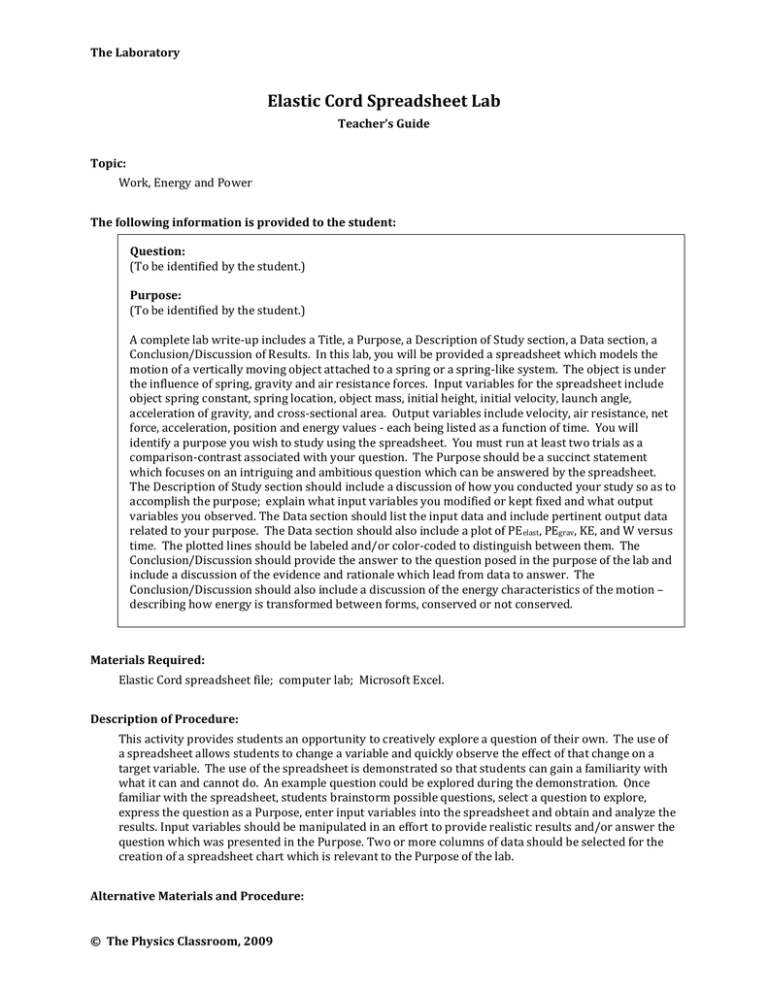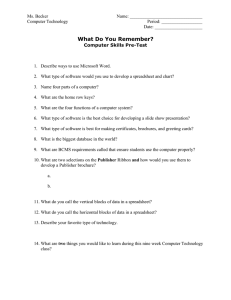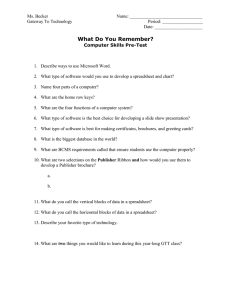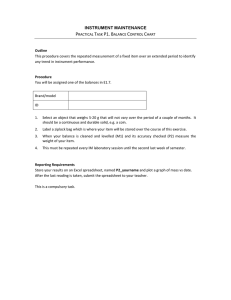Elastic Cord Spreadsheet Lab
advertisement

The Laboratory Elastic Cord Spreadsheet Lab Teacher’s Guide Topic: Work, Energy and Power The following information is provided to the student: Question: (To be identified by the student.) Purpose: (To be identified by the student.) A complete lab write-up includes a Title, a Purpose, a Description of Study section, a Data section, a Conclusion/Discussion of Results. In this lab, you will be provided a spreadsheet which models the motion of a vertically moving object attached to a spring or a spring-like system. The object is under the influence of spring, gravity and air resistance forces. Input variables for the spreadsheet include object spring constant, spring location, object mass, initial height, initial velocity, launch angle, acceleration of gravity, and cross-sectional area. Output variables include velocity, air resistance, net force, acceleration, position and energy values - each being listed as a function of time. You will identify a purpose you wish to study using the spreadsheet. You must run at least two trials as a comparison-contrast associated with your question. The Purpose should be a succinct statement which focuses on an intriguing and ambitious question which can be answered by the spreadsheet. The Description of Study section should include a discussion of how you conducted your study so as to accomplish the purpose; explain what input variables you modified or kept fixed and what output variables you observed. The Data section should list the input data and include pertinent output data related to your purpose. The Data section should also include a plot of PE elast, PEgrav, KE, and W versus time. The plotted lines should be labeled and/or color-coded to distinguish between them. The Conclusion/Discussion should provide the answer to the question posed in the purpose of the lab and include a discussion of the evidence and rationale which lead from data to answer. The Conclusion/Discussion should also include a discussion of the energy characteristics of the motion – describing how energy is transformed between forms, conserved or not conserved. Materials Required: Elastic Cord spreadsheet file; computer lab; Microsoft Excel. Description of Procedure: This activity provides students an opportunity to creatively explore a question of their own. The use of a spreadsheet allows students to change a variable and quickly observe the effect of that change on a target variable. The use of the spreadsheet is demonstrated so that students can gain a familiarity with what it can and cannot do. An example question could be explored during the demonstration. Once familiar with the spreadsheet, students brainstorm possible questions, select a question to explore, express the question as a Purpose, enter input variables into the spreadsheet and obtain and analyze the results. Input variables should be manipulated in an effort to provide realistic results and/or answer the question which was presented in the Purpose. Two or more columns of data should be selected for the creation of a spreadsheet chart which is relevant to the Purpose of the lab. Alternative Materials and Procedure: © The Physics Classroom, 2009 The Laboratory An alternative approach to this activity involves generating a collection of questions to study. Each student or student lab group is then assigned their own question to explore. Safety Concern: There is always a higher than usual level of risk associated with working in a science lab. Teachers should be aware of this and take the necessary precautions to insure that the working environment is as safe as possible. Student horseplay and off-task behaviors should not be tolerated. Suggestions, Precautions, Notes: 1. 2. 3. Access to a computer lab and a license to use Microsoft Excel is required for this activity. This activity is more of a project than it is a lab. Students will need some time to explore. It is a wise tactic to break the project up into attainable sub-goals. For instance, the project could be divided into the following sections: brainstorming, project proposal and approval, development of a methodology, collection of data, reporting of results. The inclusion of air resistance effects makes the spreadsheet unique and interesting. Realistic modeling of the motion of objects is possible. All motions are restricted to linear motion. Auxiliary Materials: None Scoring Rubric: E10. Elastic Cord Spreadsheet Analysis Lab Included, labeled and organized all parts of the lab report. Purpose section includes a succinctly worded statement which clarifies the intention of the study. Description of Study section describes details related to how the study was conducted. Independent and dependent variables are discussed. The procedure which was used was related to the purpose. Data section identifies the input variables for all trials; units are stated. Reasonable values were used for all inputs. Relevant output variables are clearly stated in an organized fashion. Included an energy-time plot clearly depicting the changes in the KE, PEgrav, PEelast and W over the course of time. Conclusion/Discussion provides the answer to the question posed in the Purpose. Answer is relevant to the purpose and reasonable. Evidence which supports the conclusions are discussed in a rational manner. Included an intelligently worded discussion of the energy of the object, describing how energy was transformed between forms, conserved or not conserved. Connections to The Physics Classroom Tutorial: The following readings are a suitable accompaniment to this lab: http://www.physicsclassroom.com/Class/energy/u5l2bb.cfm http://www.physicsclassroom.com/Class/energy/u5l2bc.cfm Connections to Minds on Physics Internet Modules: © The Physics Classroom, 2009 Score _____/_____ The Laboratory Sublevels 9 and 10 of the Work and Energy module are a suitable accompaniment to this lab: http://www.physicsclassroom.com/mop/module.cfm © The Physics Classroom, 2009





